北师大版(2019)选择性必修第一册Unit 3 Conservation Viewing Workshop课件(共23页)
文档属性
| 名称 | 北师大版(2019)选择性必修第一册Unit 3 Conservation Viewing Workshop课件(共23页) | 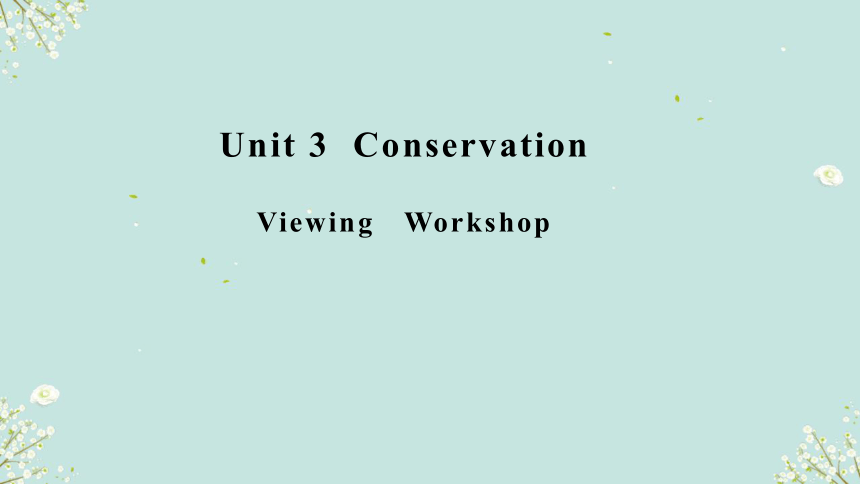 | |
| 格式 | pptx | ||
| 文件大小 | 10.5MB | ||
| 资源类型 | 教案 | ||
| 版本资源 | 北师大版(2019) | ||
| 科目 | 英语 | ||
| 更新时间 | 2024-10-03 22:09:41 | ||
图片预览

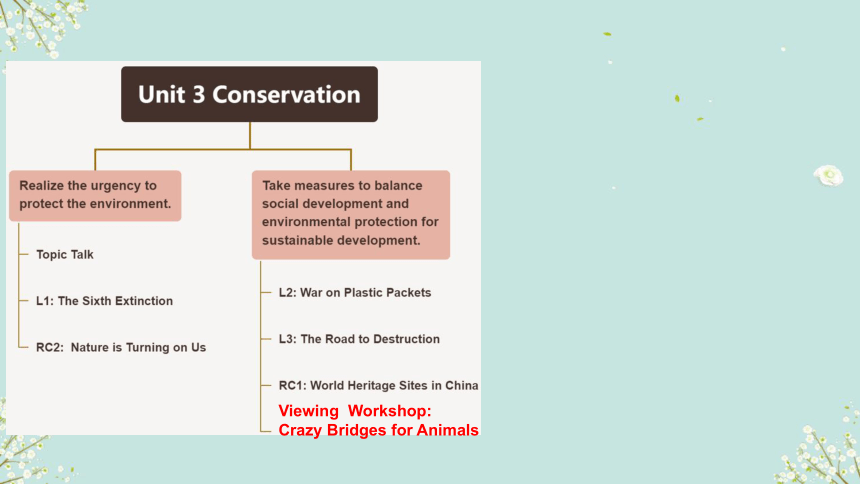
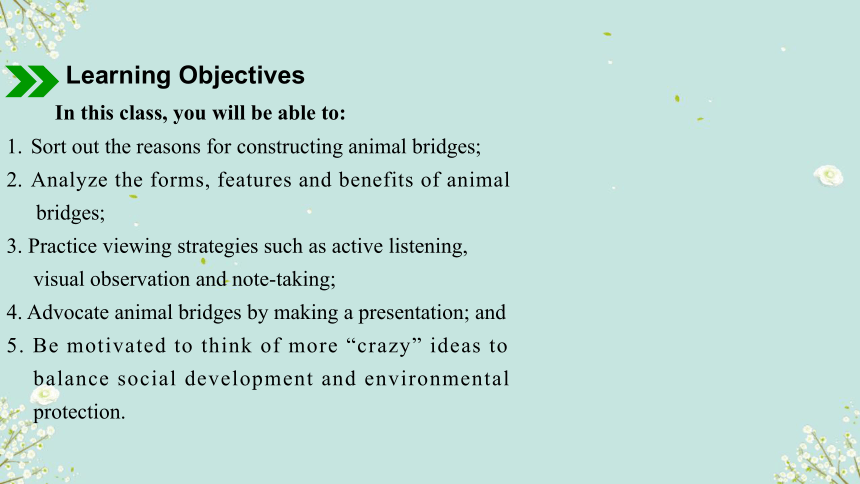
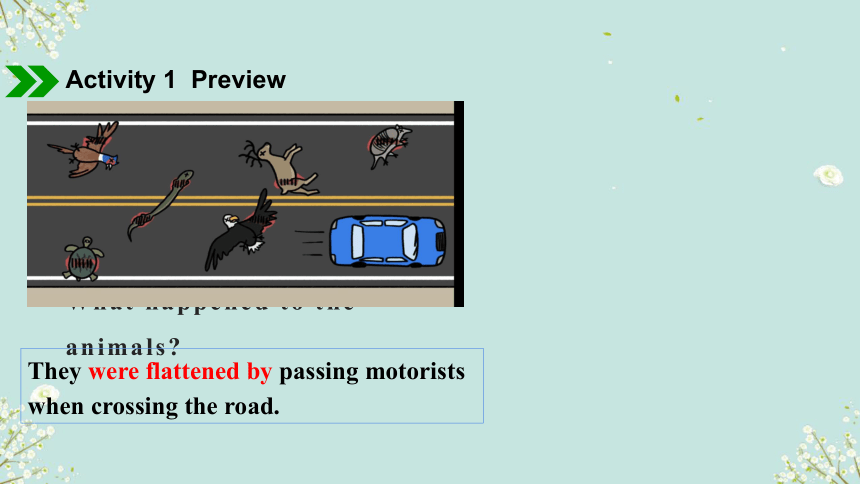

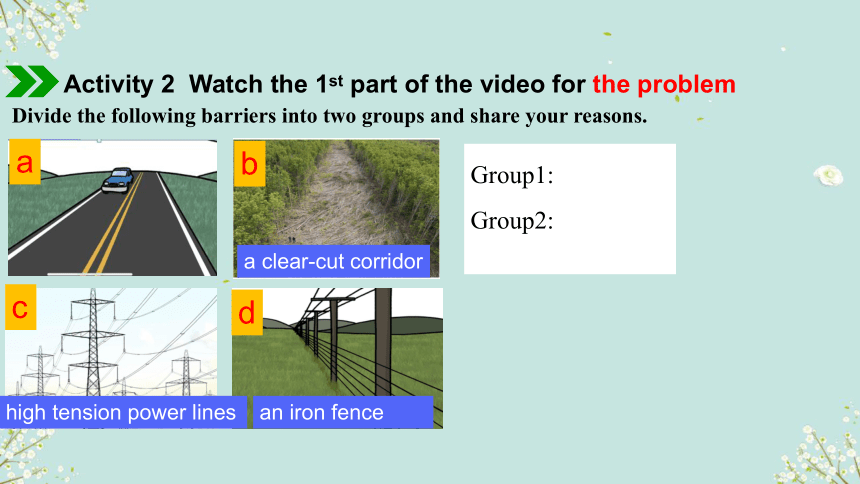
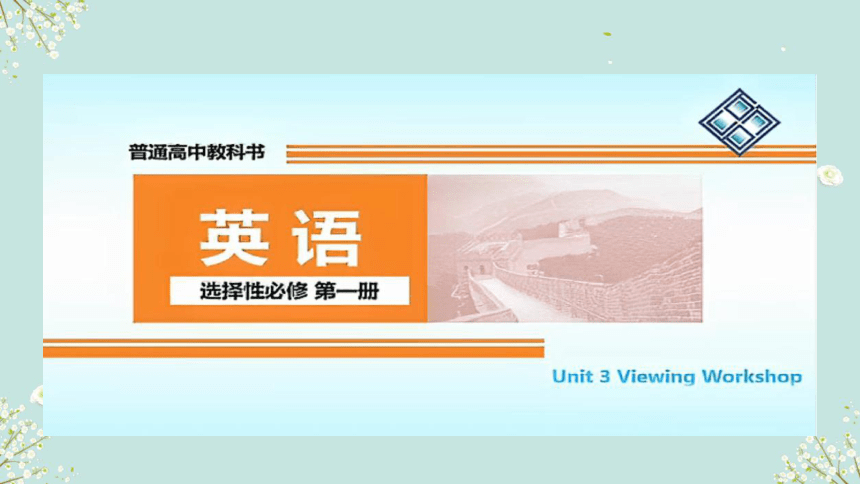
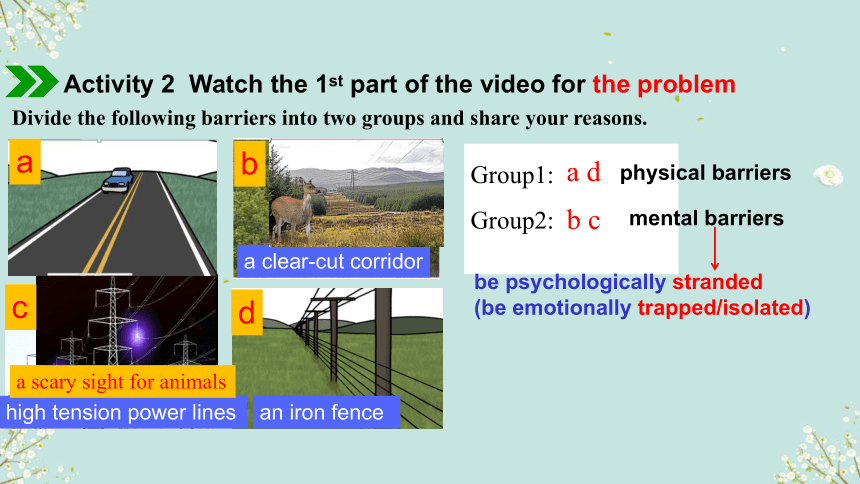

文档简介
(共23张PPT)
Unit 3 Conservation
Viewing Workshop
Viewing Workshop:
Crazy Bridges for Animals
Learning Objectives
In this class, you will be able to:
Sort out the reasons for constructing animal bridges;
Analyze the forms, features and benefits of animal
bridges;
3. Practice viewing strategies such as active listening,
visual observation and note-taking;
4. Advocate animal bridges by making a presentation; and
5. Be motivated to think of more “crazy” ideas to
balance social development and environmental
protection.
What happened to the animals
Activity 1 Preview
They were flattened by passing motorists when crossing the road.
They were flattened by passing motorists when crossing the road.
problem
be confronted with barriers
solution
“Crazy bridges for animals”
This video presents different barriers that animals face when living in human-built environments, and also offers some solutions.
Activity 2 Watch the 1st part of the video for the problem
Divide the following barriers into two groups and share your reasons.
a
b
c
d
Group1:
Group2:
a clear-cut corridor
an iron fence
high tension power lines
Activity 2 Watch the 1st part of the video for the problem
Divide the following barriers into two groups and share your reasons.
a
b
c
d
Group1:
Group2:
a clear-cut corridor
an iron fence
high tension power lines
a d
b c
physical barriers
mental barriers
be psychologically stranded
(be emotionally trapped/isolated)
a scary sight for animals
Watch twice. Take down notes and finish the sentence.
Activity 3 Watch the 2nd part of the video for the consequences
While one stranded cow might not be a huge problem, if enough animals _______________________________________________ , entire populations can dwindle and ___________.
Activity 3 Watch the 2nd part of the video for the consequences
While one stranded cow might not be a huge problem, if enough animals _______________________________________________ , entire populations can dwindle and _________________.
become isolated from food, mates and protection
even disappear
Watch twice. Take down notes and finish the sentence.
become gradually smaller in number
Activity 4 Watch the rest part of the video for the solutions
1. Is removing all the obstacles a good idea Why
2. Design bridges for deer and elephants respectively based on the video and draw on paper.
Activity 4 Watch the rest part of the video for the solutions
1. Is removing all the obstacles a good idea Why
2. Design bridges for deer and elephants respectively based on the video and draw on paper.
No. 1. We aren’t likely to give up infrastructure (roads, power or pipelines) anytime soon.
2. Even when we remove physical barriers, mental barriers remain (their stopping power can stick around).
overpass bridges
underpass bridges
Viewing strategies:
active listening
visual observation
note-taking
guide animals over, under or around the obstacles
accommodate various sizes of animals
Activity 5 Watch another video and discuss for further exploration
1. Why are wildlife bridges called “crazy” bridges for animals
2. What are the benefits of building wildlife bridges
Work in pairs and discuss:
https://www./video/BV1wk4y1G7BM/ vd_source=fbb445f86fc71350959448cec1bff855
ingenious (creative/ be specially designed)
diverse (accommodate various sizes of animals)
wildlife-friendly(adapt to natural environment)
practical
safe
effective
heartwarming
1. Why are wildlife bridges called “crazy” bridges for animals
features of wildlife bridges
crazy
harmonious coexistence of humans and animals
traffic accidents
habitat/territory
migration
food
mates
…
decrease the risk of traffic accidents
reconnect divided habitats
expand animals’ territories
help continue their migration
guide them to find food/water resources/ mates
increase their chances of survival
2. What are the benefits of building wildlife bridges
Activity 6 Make a presentation for advocating animal bridges
Part1: reasons for constructing animal bridges(problem faced by wild animals and consequences)
Part2: forms and features of animal bridges
Part3: benefits of animal bridges
Good morning, everyone! Today I am thrilled to present animal bridges to you .
Let us embrace this innovative solution .Together, we can pave the way for a balance between social development and environmental protection.
Greeting
Body
Work in groups to deliver a speech to your classmates.
Ending
Evaluation Points Scores
1. I have learned some new expressions in the video, such as “be flattened by”, “be confronted with”, “be isolated”, etc.
2. I have applied some viewing strategies such as active listening, visual observation and note-taking.
3. I have learned about why it is important to build animal bridges.
4. I have gained insight into animal bridges, including its forms, features and benefits.
5. I have been prepared to make a presentation to advocate animal bridges.
6. I am motivated to think of more “crazy” and innovative ideas to achieve more balances between social development and environmental protection.
Self-assessment
Homework
Work in groups. Research animal bridges in China with the help of the following news links and make a PowerPoint presentation to promote them.
https://www.chinadaily./a/201906/25/WS5d115f0fa3103dbf14329f76.html
https://bbs./102020_group_726/detail41403375/
http://www..cn/v/news/2014-08/11/content_33201419.htm
https://tv./2023/08/02/VIDEnQ4gBY6uJIVwI332lozt230802.shtml
Unit 3 Conservation
Viewing Workshop
Viewing Workshop:
Crazy Bridges for Animals
Learning Objectives
In this class, you will be able to:
Sort out the reasons for constructing animal bridges;
Analyze the forms, features and benefits of animal
bridges;
3. Practice viewing strategies such as active listening,
visual observation and note-taking;
4. Advocate animal bridges by making a presentation; and
5. Be motivated to think of more “crazy” ideas to
balance social development and environmental
protection.
What happened to the animals
Activity 1 Preview
They were flattened by passing motorists when crossing the road.
They were flattened by passing motorists when crossing the road.
problem
be confronted with barriers
solution
“Crazy bridges for animals”
This video presents different barriers that animals face when living in human-built environments, and also offers some solutions.
Activity 2 Watch the 1st part of the video for the problem
Divide the following barriers into two groups and share your reasons.
a
b
c
d
Group1:
Group2:
a clear-cut corridor
an iron fence
high tension power lines
Activity 2 Watch the 1st part of the video for the problem
Divide the following barriers into two groups and share your reasons.
a
b
c
d
Group1:
Group2:
a clear-cut corridor
an iron fence
high tension power lines
a d
b c
physical barriers
mental barriers
be psychologically stranded
(be emotionally trapped/isolated)
a scary sight for animals
Watch twice. Take down notes and finish the sentence.
Activity 3 Watch the 2nd part of the video for the consequences
While one stranded cow might not be a huge problem, if enough animals _______________________________________________ , entire populations can dwindle and ___________.
Activity 3 Watch the 2nd part of the video for the consequences
While one stranded cow might not be a huge problem, if enough animals _______________________________________________ , entire populations can dwindle and _________________.
become isolated from food, mates and protection
even disappear
Watch twice. Take down notes and finish the sentence.
become gradually smaller in number
Activity 4 Watch the rest part of the video for the solutions
1. Is removing all the obstacles a good idea Why
2. Design bridges for deer and elephants respectively based on the video and draw on paper.
Activity 4 Watch the rest part of the video for the solutions
1. Is removing all the obstacles a good idea Why
2. Design bridges for deer and elephants respectively based on the video and draw on paper.
No. 1. We aren’t likely to give up infrastructure (roads, power or pipelines) anytime soon.
2. Even when we remove physical barriers, mental barriers remain (their stopping power can stick around).
overpass bridges
underpass bridges
Viewing strategies:
active listening
visual observation
note-taking
guide animals over, under or around the obstacles
accommodate various sizes of animals
Activity 5 Watch another video and discuss for further exploration
1. Why are wildlife bridges called “crazy” bridges for animals
2. What are the benefits of building wildlife bridges
Work in pairs and discuss:
https://www./video/BV1wk4y1G7BM/ vd_source=fbb445f86fc71350959448cec1bff855
ingenious (creative/ be specially designed)
diverse (accommodate various sizes of animals)
wildlife-friendly(adapt to natural environment)
practical
safe
effective
heartwarming
1. Why are wildlife bridges called “crazy” bridges for animals
features of wildlife bridges
crazy
harmonious coexistence of humans and animals
traffic accidents
habitat/territory
migration
food
mates
…
decrease the risk of traffic accidents
reconnect divided habitats
expand animals’ territories
help continue their migration
guide them to find food/water resources/ mates
increase their chances of survival
2. What are the benefits of building wildlife bridges
Activity 6 Make a presentation for advocating animal bridges
Part1: reasons for constructing animal bridges(problem faced by wild animals and consequences)
Part2: forms and features of animal bridges
Part3: benefits of animal bridges
Good morning, everyone! Today I am thrilled to present animal bridges to you .
Let us embrace this innovative solution .Together, we can pave the way for a balance between social development and environmental protection.
Greeting
Body
Work in groups to deliver a speech to your classmates.
Ending
Evaluation Points Scores
1. I have learned some new expressions in the video, such as “be flattened by”, “be confronted with”, “be isolated”, etc.
2. I have applied some viewing strategies such as active listening, visual observation and note-taking.
3. I have learned about why it is important to build animal bridges.
4. I have gained insight into animal bridges, including its forms, features and benefits.
5. I have been prepared to make a presentation to advocate animal bridges.
6. I am motivated to think of more “crazy” and innovative ideas to achieve more balances between social development and environmental protection.
Self-assessment
Homework
Work in groups. Research animal bridges in China with the help of the following news links and make a PowerPoint presentation to promote them.
https://www.chinadaily./a/201906/25/WS5d115f0fa3103dbf14329f76.html
https://bbs./102020_group_726/detail41403375/
http://www..cn/v/news/2014-08/11/content_33201419.htm
https://tv./2023/08/02/VIDEnQ4gBY6uJIVwI332lozt230802.shtml
同课章节目录
- Unit 1 Relationshis
- Lesson 1 Teachers
- Lesson 2 How Do We Like Teachers’ Feedback?
- Lesson 3 So Close,Yet So Fa
- Unit 2 Success
- Lesson 1 Money vs Success
- Lesson 2 Top Five Secrets of Success
- Lesson 3 Getting to the Top
- Unit 3 Conservation
- Lesson 1 The Sixth Extinction
- Lesson 2 War on Plastic Packets
- Lesson 3 The Road to Destruction
